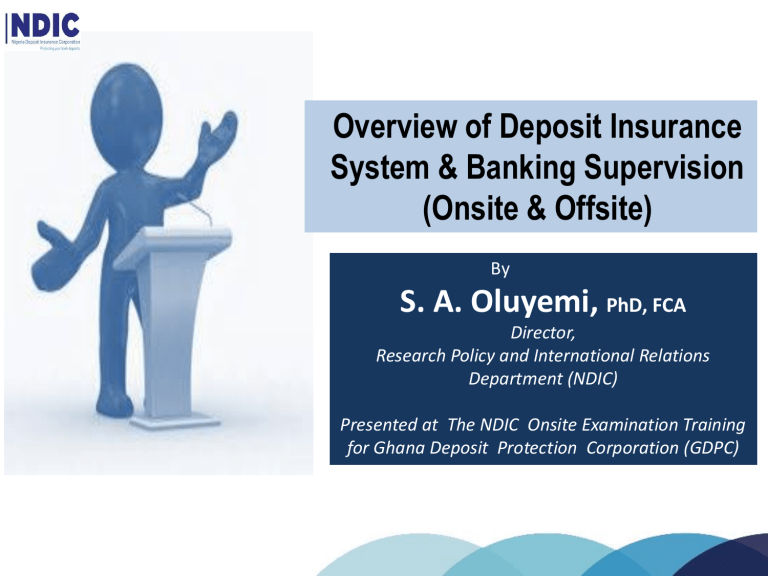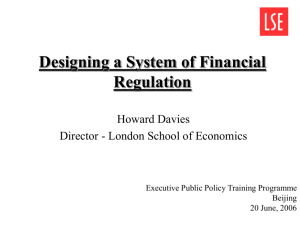
Overview of Deposit Insurance System & Banking Supervision (Onsite & Offsite) By S. A. Oluyemi, PhD, FCA Director, Research Policy and International Relations Department (NDIC) Presented at The NDIC Onsite Examination Training for Ghana Deposit Protection Corporation (GDPC) Outline Introduction Rationale for establishing a DIS DIS Public Policy Objective Objectives of Banking Supervision and Prudential Regulation Banking Supervision Methodology (Onsite & Offsite) Summary INTRODUCTION One of the interventions of Government in managing the antecedent effects of bank failures to the economy of any country in the world is through Deposit Insurance. Deposit insurance has been defined as a financial guarantee to protect depositors in the event of a bank failure and also to offer a measure of safety for the banking system Countries face a choice between explicit (defined with specific mandate) and implicit (at government discretion) deposit insurance systems. On of such mandates of the explicit DIS is Bank supervision. Bank Supervision is a statutory function, performed by a specialised agency, that entails monitoring of commercial banks and other banking institutions for compliance with applicable rules, seeks to reduce the potential risk of failure and ensures that unsafe and unsound banking practices do not go unchecked. 3 RATIONALE FOR ESTABLISHING DIS IN NIGERIA The decision by the Federal government of Nigeria to establish the NDIC was informed by a number of factors. These included: –the country’s past bitter experience of bank failures –the lessons of other countries’ experiences with deposit insurance schemes, banking competition –the need for effective supervision/prudential regulation –change in government bank support policy. 4 RATIONALE FOR ESTABLISHING DIS IN NIGERIA Lessons of History: Bank Failures in Nigeria The period between 1947 and 1952 witnessed a rapid growth of indigenous banks in Nigeria. This was before the establishment of the Central Bank of Nigeria in 1958, which commenced operations in 1959. The increase in the number of indigenous banks was followed also by a high rate of failures of such banks. By 1954, twenty-one (21) out of twenty-five (25) indigenous banks operating in Nigeria had failed. The Federal Government of Nigeria did not want Nigerians to relive those experiences, it was considered that the establishment of a Deposit Insurance Scheme was urgently needed. 5 RATIONALE FOR ESTABLISHING DIS IN NIGERIA Lessons from Other Countries the former Czechoslovakia which established a nationwide deposit insurance scheme in 1924 and the USA in 1933, to revamp their banking systems and by extension their respective economies, many countries, including Nigeria, joined the league of nations with DISs. Notwithstanding the fact that bank failures are still rife in the U.S., the FDIC has made it painless on the American financial system and has thus engendered public confidence in the banking system. 6 RATIONALE FOR ESTABLISHING DIS IN NIGERIA Anticipated Consequences of Economic Reforms on Banking Supervision. The Structural Adjustment Programme (SAP) embarked upon by government in 1986 was aimed at deregulating the economy and removing all distortions created by the hitherto administrative policies of government. It was envisaged that since the reform involved the liberalisation of the bank licensing process, there would be a substantial increase in the number of licensed banks to be supervised by the CBN. The establishment of an explicit deposit insurance scheme with supervisory powers over insured institutions was expected to complement the supervisory efforts of the CBN. Indeed, since the establishment of the Corporation in 1989, it has been possible for both institutions (the CBN and NDIC) to carry out routine and special examinations of licensed banks. 7 RATIONALE FOR ESTABLISHING DIS IN NIGERIA Increased Competition Among Banks It was envisaged that with the rapid growth in the number of newly licensed banks, there would be increased competition. Whereas, competition is good for individual banks, the customers, and the banking system, increased competition could encourage, excessive risk-taking with depositors’ funds. It was therefore necessary to protect the depositors, especially the small ones, against loss of the their deposits from excessive risks undertaken by their banks. 8 RATIONALE FOR ESTABLISHING DIS IN NIGERIA Change in Government Bank Support Policy Prior to the establishment of the Corporation, government had been unwilling to let any bank fail, no matter the bank’s financial condition and/or quality of management. Government was apprehensive of the potential adverse effects on confidence in the banking system and in the economy generally following a bank failure. Consequently, government deliberately propped up a number of inefficient banks over the years, especially those banks in which state governments were the majority shareholders. 9 IADI CORE Principle 1: Public Policy Objectives The principal public policy objectives for DISs are to protect depositors and contribute to financial stability. These objectives should be formally specified and publicly disclosed. The design of the DISs should reflect the system’s public policy objectives. PUBLIC POLICY OBJECTIVES OF NDIC The public policy objectives of the NDIC are as follows: Protecting depositors by providing an orderly medium for reimbursement to depositors in the case of imminent or actual failure of a licensed deposit-taking financial institution; Contributing to financial system stability by making incidence of bank runs less likely; and Enhancing public confidence by providing a framework for the resolution and orderly exit of failing and failed insured institutions. The NDIC Act establishes the Corporation as a risk minimiser as opposed to a pay box by conferring on it powers to supervise all insured institutions 11 MANDATE OF THE DIS IN NIGERIA Deposit Guarantee The key and distinct function of the Corporation is the guarantee to pay up to maximum of N500,000.00 to depositors of failed licensed banks [International, National and Regional] and N100,000.00 to depositors of failed MFBs and PMIs. S 20[1] NDIC Act as amended by powers conferred on the Board of the Corporation in that regard. Banking Supervision As a risk minimiser, the Corporation carries out supervision of insured institutions in order to reduce the potential risk of failure and to ensure that unsafe and unsound banking practices do not go unchecked. Supervision is carried out through off site surveillance and on site examination. Failure Resolution The Corporation is charged with the responsibility of ensuring that failing and failed insured institutions are resolved in a timely manner. Bank liquidation The Corporation is conferred with the office of Provisional Liquidator of Failed Banks pursuant to its enabling Act in order to ensure the orderly and efficient closure of failed institutions with minimum disruption to the banking system, utilizing cost effective realization of assets and facilitating prompt settlement of claims of depositors, creditors and shareholders, where possible. 12 Objectives of Banking Supervision and Prudential Regulation Banking supervision and prudential regulation generally seeks to reduce the potential risk of failure and ensures that unsafe and unsound banking practices do not go unchecked. Specifically, it aims to: • Safeguard the financial system against risk of disruption and mass failure of banks • Reduce the level of risk to which bank, depositor, creditors and other stakeholders are exposed to • Minimize Money Laundering activities in the financial system • Enhance the efficiency of the financial system • Supporting productive and social activities by channeling resources to priority sectors of the economy 13 Banking Supervision and Prudential Regulation • Books and affairs of every licensed insured institution are examined as a means of meeting its supervisory mandate. • This function is performed through the off-site surveillance and on-site examination of the books and affairs of the banks. – Exceptions are reported, – Recommendations made on how the observed lapses can be corrected, and – The implementation of such recommendations is monitored through scheduled post examination visits to the affected banks. SUPERVISORY ACTIVITIES OF THE NDIC • Forms of Bank supervision – Off-site surveillance – On-site examination • On site examination – This entails examination of a bank’s reports, document and other materials within the premises of the bank, and the reconciliation of the information derived from the examined documents with physical realities/assets such as cash and other inventories to determine whether – the bank complies with the bank regulation – the returns sent by the bank are congruent to physical realities in the bank – the results/findings of the off-site analysis of the bank’s return describe the bank’s financial risk performance SUPERVISORY ACTIVITIES OF THE NDIC • Off-site Surveillance – Off-site supervision involves the receipt and analysis of returns from insured banks on a periodic basis to ascertain the banks’ compliance with prudential regulations. – Returns, basically, are requirements of the regulatory/supervisory authorities from the banking institutions which are made on determined periodic basis to assist in ensuring that the banks conform to desired operating rules. SUPERVISORY ACTIVITIES OF THE NDIC – Two categories of regulatory returns can be identified: statutory and non-statutory returns. – Statutory returns are the returns that must be made by financial institutions as provided for in various acts governing the banking business. – Non-statutory returns on the other hand are those returns which the regulatory/supervisory authorities can require from banks in their day to day operations. These non-statutory returns are usually called for by means of circulars or questionnaires. SUPERVISORY ACTIVITIES OF THE NDICMethodology of Supervision • Compliance/Transaction Based Supervision • Risk Based Supervision • Compliance-based examination – also known as rule or principle-based. – A method of examination which involves checking for and enforcing compliance with rules – legislation, regulations or policies – that apply to a bank or a given banking industry. – However, it is a reactive, and not proactive, form of supervision. It is static and less useful in a dynamic, constantly-evolving world SUPERVISORY ACTIVITIES OF THE NDICMethodology of Supervision (Contd.) • Risk Based Supervision (RBS) – A structured process aimed at identifying the most critical risks that face each bank and through a focused review by the supervisor to assess the bank’s management of those risks and the bank’s financial vulnerability to potential adverse experience. – Risk Based Supervision is a comprehensive, formally structured system that assesses risks within the Risk Based Supervision financial system, giving priority to the resolution of those risks. – Special effort is made to understand the environment in which the deposit taking financial institution operates. SUPERVISORY ACTIVITIES OF THE NDIC RBS (Contd.) – The inherent risks are identified, the Risk Management Control Functions are appraised to the extent used to mitigate the risks. – RBS is gradually becoming the dominant approach to regulatory supervision of financial institutions around the world. – Emphasis is placed on the RMCFs (Board, Senior Management, Risk Management, Internal Audit, Compliance and Financial Analysis) capacity to manage the inherent risks i.e. Credit, Operational, Liquidity, Market etc. SUPERVISORY ACTIVITIES OF THE NDIC - RBS (Contd.) – It is a robust, proactive and sophisticated supervisory process, essentially based on the risk profiling of a bank; – It enables a better evaluation of risks through the separate assessment of inherent risks and risk management processes; – It is a dynamic, forward looking process, placing greater emphasis on the early identification of emerging risks and system-wide issues – It allows the supervisor to prioritize efforts and focus on significant risks by channeling resources to banks that have higher risk profiles. SUPERVISORY ACTIVITIES OF THE NDIC – Scope of Bank Supervision Scope of Bank Supervision • Solo Based Supervision • Consolidated Supervision • Cross Border Supervision • Solo Based Supervision – Solo examination focuses on a single bank, its distinct individual operations, risk profile and management. – This supervisory approach focuses on individual group entities. Individual entities are supervised on a solo basis according to the capital requirements of their respective regulators. SUPERVISORY ACTIVITIES OF THE NDICConsolidated Supervision • Consolidated Supervision – This is a general qualitative assessment of the group as a whole and, usually, by a quantitative group-wide assessment of the adequacy of capital. – A qualitative and quantitative assessment of the strength of those business groups which contain banks (and other regulated financial institutions) in order to identify and evaluate all the risks to which the banks are exposed. • Supervisory Activities of the NDICConsolidated Supervision Rationale – Some banks are themselves subsidiaries and exposed to risks arising from the influence exercised over them by their parents. – Many banks and subsidiaries are exposed to risks arising from the influence of parent companies. – The impact of the global melt down showed that some events could have been projected if regulators/supervisors had adopted a holistic approach rather than resolving issues from a ‘’solo’’ perspective. – Consolidated supervision is an essential element of risk based supervision. – The adoption of Universal Banking in Nigeria in 2001 brought additional challenges to the Regulatory Authorities. As such, many banks carried on activities through subsidiaries/affiliates. SUPERVISORY ACTIVITIES OF THE NDIC– Consolidated Supervision (Contd.) • Objectives of Consolidated Supervision – Supports principle that no business segment risk escapes. – Supervision prevents over leveraging of Capital (Double Gearing) control. – Evaluates strength of the Group Consolidated Financial Resources. Conclusion • The foregoing has touched key issues in supervision of financial institutions in the banking industries in Nigeria. • Understanding these issues will help in appreciating the tools, strategies and policies of DIS and by extension bank supervision as employed by the NDIC.


